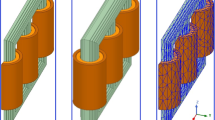Abstract
To obtain more precise and rational calculation details of the loss and heat of a damper winding in a tubular hydro-generator, this study develops a three-dimensional, finite-element, electromagnetic-temperature field close-coupling model of the damper winding. On the basis of multi-physical field coupled theory, the model fully considers the temperature effects of the damper winding resistivities and heat conductivities, and the eddy current loss in the end region of the damper winding. The model was verified by direct tests of the damper winding temperature. Unlike the conventional weak-coupling model, the proposed close-coupling model fully captures the interaction between the electromagnetic and temperature fields. Therefore, of the model more accurately and reasonably calculates the loss and heat of the damper winding than the conventional model. The proposed calculation model can properly assess the loss and heat of damper windings in large hydro-generators, which is helpful for improving the design standards of hydro-generators.














Similar content being viewed by others
References
Chen X-f (2013) Electromagnetic calculation of hydro-generator. China Water Power Press, Beijing
Guo JB (2001) Analysis of damaged damping winding and magnetic pole in bulb type generator. Chin Power 34(7):63–67
Deng D, Sun YT, Tan GW, Li JX, Hua Z (2003) Analysis on operating faults of generator in feilaixia hydropower station. Large Electr Mach Hydraulic Turb 7:13–17
Hameyer K, Driesen J, Gersem HD, Belmans R (1999) The classification of coupled field problems. IEEE Trans Magn 35(3):1618–1621
Boglietti A, Cavagnino A, Staton D, Martin SM, Mueller M, Mejuto C (2009) Evolution and modern approaches for thermal analysis of electrical machines. IEEE Trans Ind Electron 56(3):871–882
Vong PK, Rodger D (2003) Coupled electromagnetic-thermal modeling of electrical machines. IEEE Trans Magn 39(3):1614–1617
Weili L, Feng Z, Yunpeng H, Shukang C (2002) Calculation of rotor temperature field for hydro-generator as well as the analysis on relevant factors. Proc CSEE 22(10):85–90
Jiabin W, Dawei M, Changbin L (2002) Synthetic calculation for the ventilation and heating of large waterwheel generator. Proc CSEE 20(11):115–119
Xia H, Yao YY, Ni GZ (2007) Analysis of ventilation fluid field and rotor temperature field of a generator. Electr Mach Control 11(5):472–476
Li W, Zhang Y, Chen Y (2011) Calculation and analysis of heat transfer coefficients and temperature fields of air-cooled largehydro-generator rotor excitation windings. IEEE Trans Energy Convers 26(3):946–952
Li W, Guan C, Chen Y (2013) Influence of rotation on rotor fluid and temperature distribution in a large air-cooled hydrogenerator. IEEE Trans Energy Convers 28(1):117–124
Kaehler C, Henneberger G (2004) Transient 3-D FEM computation of eddy-current losses in the rotor of a claw-pole alternator. IEEE Trans Magn 40(2):1362–1365
Fan Z, Liao Y, Han L, Xie L (2013) No-load voltage waveform optimization and damper bars heat reduction of tubular hydro-generator by different degree of adjusting damper bar pitch and skewing stator slot. IEEE Trans Energy Convers 28(3):461–469
Liao Y, Fan Z, Han L, Xie L (2012) Analysis of the loss and heat on damper bars in large tubular hydro-generator base on the 3D electromagnetic-temperature field calculation. Przeglad Elektrotechniczny 88(5B):97–100
Weilharter B, Biro O, Rainer S, Stermecki A (2011) Computation of rotating force waves in skewed induction machines using multi-slice models. IEEE Trans Magn 47(5):1046–1049
Keranen J, Ponomarev P, Pippuri J (2017) Parallel performance of multi-slice finite-element modeling of skewed electrical machines. IEEE Trans Magn 53(6):1204–1207
Knight AM, Troitskaia S, Stranges N, Merkhouf A (2009) Analysis of large synchronous machines with axial skew, part 2: inter-bar resistance, skew and losses. IET Electr Power Appl 3(5):398–406
Huangfu Y, Wang S, Qiu J, Zhang H et al (2014) Transient performance analysis of induction motor using field-circuit coupled finite-element method. IEEE Trans Magn 50(2):2283–2286
Sarikhani A, Nejadpak A, Mohammed OA (2013) Coupled field-circuit estimation of operational inductance in PM synchronous machines by a real-time physics-based inductance observer. IEEE Trans Magn 49(5):2283–2286
Bergeron M, Cros J, Niehenke J et al (2016) Hydro generator damper bar current measurement at Wanapum Dam. IEEE Trans Energy Convers 31(4):1510–1520
Karmaker H, Knight AM (2005) Investigation and simulation of fields in large salient-pole synchronous machines with skewed Stator slots. IEEE Trans Energy Convers 20(3):604–610
Acknowledgements
This work was sponsored by the National Natural Science Youth Fund of China, nos. 51607146 and 61703345, the Key Scientific Research Fund from Xihua University, nos. Z1520907 and Z1520909, and the Key Research fund projects of the Sichuan Provincial Education Department, nos. 16ZA0155 and 16ZB0159. This work was also supported by the Sichuan Science and Technology Program, No. 2018GZ0391, 2017GZ0358, and 2017JY0204, the Sichuan Province Key Laboratory of Power Electronics Energy-saving Technologies & Equipment, no. szjj2016-048, a Grant from the Chunhui Project Foundation of the Education Department of China, no. Z2016144, and the International Cooperation Project of the Chengdu Science and Technology Bureau, no. 2016-GH02-00111-Hz. It was also sponsored by the Key Laboratory of Fluid and Power Machinery (Xihua University), Ministry of Education, China (no. SBZDPY-11-14).
Author information
Authors and Affiliations
Corresponding author
Additional information
Publisher's Note
Springer Nature remains neutral with regard to jurisdictional claims in published maps and institutional affiliations.
Rights and permissions
About this article
Cite this article
Wen, K., Han, L., Zhou, Zt. et al. 3D Electromagnetic-Temperature Field Close-Coupling Calculation of Losses and Heat in the Damper Winding of a Large Tubular Hydro-Generator. J. Electr. Eng. Technol. 14, 1255–1268 (2019). https://doi.org/10.1007/s42835-019-00143-8
Received:
Revised:
Accepted:
Published:
Issue Date:
DOI: https://doi.org/10.1007/s42835-019-00143-8




